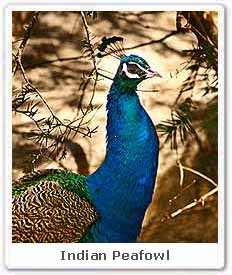| Kingdom : | Animalia |
| Phylum : | Chordata |
| Class: | Aves |
| Order : | Galliformes |
| Family : | Phasianidae |
| Genus : | Pavo |
| Species : | P. cristatus |
| Zoological name : | Pavo cristatus |
| Found In | Sariska Tiger Reserve, Kanha National Park and Ranthambore National Park |
 Physical appearance : Males are about 107 cm long and
females are about 86 cm long. Males weigh around 5 kg and the females weigh
around 3.4 kg. Both have fan shaped crest on their head. Three toes face
forward and one backward. The most attracting part of the peacock is the fan
or train of feathers that grow from its shimmering blue back. The train is
approximately 1.6 m in length. It can also raise its train of feathers. The
peahens do not have train, her plumage is brown, white and black in colour.
They have royal blue neck and breast. Indian Peafowl is one of the most
colorful bird. It is the largest member of pheasant and turkey family.
Physical appearance : Males are about 107 cm long and
females are about 86 cm long. Males weigh around 5 kg and the females weigh
around 3.4 kg. Both have fan shaped crest on their head. Three toes face
forward and one backward. The most attracting part of the peacock is the fan
or train of feathers that grow from its shimmering blue back. The train is
approximately 1.6 m in length. It can also raise its train of feathers. The
peahens do not have train, her plumage is brown, white and black in colour.
They have royal blue neck and breast. Indian Peafowl is one of the most
colorful bird. It is the largest member of pheasant and turkey family.Presence in India : Peafowls are found all over India. In Haryana they are found in almost every village. They can be spotted in Sariska Tiger reserve, Kanha National Park and Ranthambore National Park. It is the National Bird of India.
Habitat : Peafowls prefers semi- desert grasslands, shrub, cultivated fields, open forests, orchards and deciduous forests.
Diet : Peafowls are omnivorous and feed on the ground. They eat seeds, grains, insects, berries, plants, fruits, reptiles, arthropods and amphibians. They mostly search for food in early morning hours or before the sunset.
Reproduction : Males attract the females with the fan dance. They lay 4- 8 eggs which are hatched within 28 days. The eggs are light brown in colour. The young ones are known as peachicks. Breading season varies geographically. Males usually mates with 2- 5 females.
Conservation status : Not endangered. They are protected throughout the country, especially under Indian wildlife protection Act 1972. Indian Peafowls are also kept as a pet. It is considered as sacred among the Hindus.
Lifespan : The average lifespan of the Indian Peafowls is about 20 years of age.






